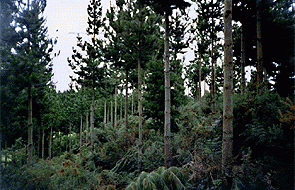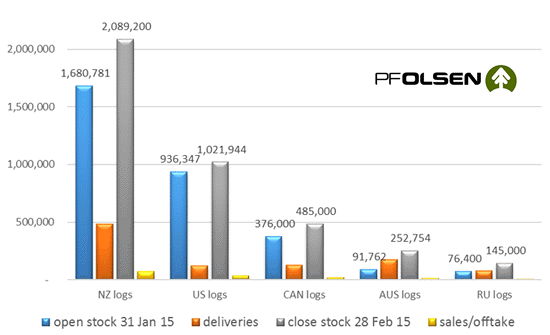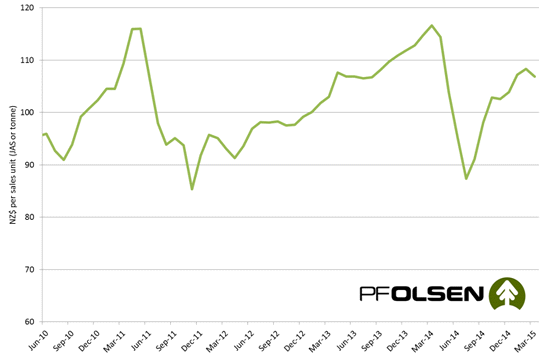

The domestic log market continues to have strong demand for higher value pruned and unpruned logs.
Some domestic mills are seeking more pruned logs than available and are having to make do with a proportion of unpruned logs in the meantime.
The export log market moved sideways in February impacted by the Chinese Lunar New Year and Spring Holiday although very favourable ocean freight rates and a weaker Kiwi dollar have supported NZ$ at-wharf-gate prices.
Export Log Market
CFR prices in China (US$ prices of logs delivered to China ports) have declined from US$130/JAS m3 to reported prices as low as US$115 currently.
This price is below the level experienced in June last year when NZ$ at-wharf-gate prices troughed at $76/JAS m3.
The difference now is that much lower ocean freight and a much lower Kiwi dollar is offsetting the lower CFR price. At US$ 115, however, the lower ocean freight and foreign exchange offsets have been used up and we are expecting to see a fall of a few NZ$ in log prices for April.
The immediate driver of the fall in CFR price is rapidly rising log stocks in China.
It took more than 6 months for stocks to reduce by over 1 million m3 to 3.1 million m3 at the end of last year. However, it took just five weeks for stocks to rebound to over 4.2 million m3 as at the 7th of March.
The Chinese Lunar New Year and Spring Holiday officially ran for just one week from the 18th to the 24th February but for most businesses this expanded to a two week, or longer, shut. Described as the largest modern annual migration of humanity, many millions of Chinese, many having moved away from rural-dwelling family, travel long distances reunite with family for celebrations.
This holiday is usually earlier in February and coincides more closely with reduced supply from exporting countries, especially New Zealand. Our similarly long holiday period over Christmas means reduced supplies to China in late January/early February after pre-Christmas ships have sailed and discharged their cargoes in the first half of January. It takes some time to build stocks again in New Zealand after the New Year start-up and significant export volumes don’t start to arrive in China until early/mid-February.
This year this coincided with a mass shut down of log processing in China (see chart below).
Log Stocks at China Sea Ports (cubic metres)

This chart graphically shows the massive build-up in log stocks as a result of the Chinese holidays. Negligible sales/offtake from the ports and reasonably solid deliveries coincided to a stock build to 4.0 million m3 by the end of February. This has subsequently grown to 4.2 million m3 in the first week of March.
Another key concern about the Chinese wood market has been Russian supply. The more than halving of the value of the Russian ruble against the US dollar means a potential ruble windfall for Russian log and lumber exporters.
International Wood Markets Group reports the supply response so far as relatively small with volumes up 10-20% higher than normal. This, however, has been enough to add to negative market sentiment especially over the low-demand Chinese holiday period.
Further out the impact is expected to continue to be relatively minor with considerable constraints to increased volumes from Russia; these include very high interest rates (25-30%), increasingly remote forests, US$ denominated rail services and very expensive prices on imported specialist harvesting machinery.
Log exports from New Zealand to Japan and South Korea remain steady. This trade has become so steady, in fact, that the 2014 and the five-year average figures of log exports from New Zealand almost the same. That is around 0.7m m3 to Japan and 2.2 m3 to South Korea annually.
While India has the potential to become a much more important market for New Zealand logs in the future volumes to this market plummeted late last year after volume diverted from oversupplied China (May-July last year) swamped the Indian market. Despite this, total log exports to India for 2014 were 28% above 2013 at 1.7 million m3. Current demand and prices, however, remain relatively weak.
Handy-size (the most common class of break-bulk vessel to carry New Zealand logs to Asian markets) vessel charter rates have risen slightly from a very low trough in mid-February, but are still at historically low rates.
February rates are understood to have reached as low as $16.50/JAS m3 for a 1:1 schedule. These low rates were also driven by an historically low oil price. While the oil price also rose through February, it has again fallen in March and, as this article goes to issue, it is was only cents away from its low for the year of US$44.45 per barrel. This recent fall will somewhat offset the increase in charter rates and should keep a lid on ocean freight rates for logs.
Domestic Log Market
Strong demand for finished products in Australasia, the USA and Europe, as well as solid demand in New Zealand, is seeing continued strong demand for pruned logs.
As reported last month, the premium for pruned logs over unpruned logs has increased.
Agrifax reports that for the first time since May 2005, pruning has become profitable again. This supports similar analysis undertaken by PF Olsen. This is based on the premium for pruned logs (over the highest quality unpruned log price) increasing to such an extent that there are now adequate investment returns on the pruning operation.
The other benefit of pruning is that it provides good option value. Even if the premium for pruned logs disappeared altogether (unlikely) then you can still sell a pruned log as an unpruned log as a contingency. This premium for pruned logs is expected by most to increase even further as the lighter/whiter Radiata pine clearwood starts to take market share from supply-constrained south-sea hardwoods and laminated panel products.
Large investments in pruned log processing in China for domestic and export furniture markets are further evidence of this trend.
Demand for structural logs is steady, with shortages appearing in Christchurch. This market has high levels of building activity with the earthquake re-build, but lost considerable mature standing timber in last year’s massive windthrow which resulted in premature “salvage” harvesting over large areas of forest.
Pulp log demand and prices remain steady as current harvesting levels yield up enough low grade arisings to satisfy demand in most regions.
The PF Olsen log price index fell just one point from $108 last month to $107 this month. It is now $22 higher than its cyclical low of $85 in November 2011 and $20 above the last low of $87 in July of 2014. The index is still $10 below the March 2014 peak of $117 but $5 higher than the four year average of $102.
PF Olsen Log Price Index

Basis of Index: This Index is based on prices in the table below weighted in proportions that represent a broad average of log grades produced from a typical pruned forest with an approximate mix of 40% domestic and 60% export supply.
Indicative Average Current Log Prices
| Log Grade | $/tonne at mill | $/JAS m3 at wharf |
| Pruned (P40) | 152 | 168 |
| Structural (S30) | 111 | |
| Structural (S20) | 97 | |
| Export A | 110 | |
| Export K | 104 | |
| Export KI | 94 | |
| Pulp | 50 |
Note: Actual prices will vary according to regional supply/demand balances, varying cost structures and grade variation. These prices should be used as a guide only and specific advice sought for individual forests.
---------------------------------------------------------------
This article is reproduced from PF Olsen's Wood Matters, with permission.
We welcome your comments below. If you are not already registered, please register to comment
Remember we welcome robust, respectful and insightful debate. We don't welcome abusive or defamatory comments and will de-register those repeatedly making such comments. Our current comment policy is here.